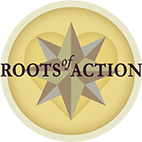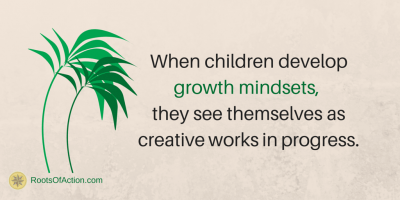
“A growth mindset is when students believe that their abilities can be developed,” says Carol Dweck, renowned Stanford University psychologist. Dweck coined the phrase growth mindset after decades of research on how children and teens become successful.
Dweck’s groundbreaking book, Mindset: The New Psychology of Success, explains that success and achievement extend beyond children’s abilities to their attitudes about learning. When children develop growth mindsets, they see themselves as creative works in progress. On the other hand, those with fixed mindsets see their abilities as static, so they avoid challenge and failure.
How does a growth mindset fuel a teenager’s ability to become a 21st century innovator? How do adults support the development of future leaders, helping them creatively imagine a new and innovative future?
To prepare for careers in complex and rapidly changing fields, middle and high school students must learn to think differently and interact with others in new and creative ways.
Take, for example, the growth mindset of Jack Andraka. At the age of 15, Jack developed an inexpensive test to detect early stage pancreatic cancer. The drive to accomplish this feat came when a close family friend passed away from pancreatic cancer. After learning that this type of cancer wasn’t usually detected until the odds of survival were very slim, Jack became more determined. Using his curiosity and creativity, along with Google and Wikipedia, Jack came up with a theory for a new pancreatic cancer test. He contacted 200 cancer researchers in hopes of finding someone who believed in him enough to provide lab space to develop his procedure. His perseverance paid off – a professor at Johns Hopkins University was willing to take a chance on young Jack.
What made a difference for Jack and encouraged him to tackle what wasn’t typical for a 15-year-old was his growth mindset. He saw a problem, and through the innovative thinking his parents had helped cultivate, and the encouragement of an expert, Jack was able to go beyond the parameters of his age and experience, and find a potential solution. Jack got it right in an interview with 60 Minutes, “You can be a genius, but if you don’t have the creativity to put that knowledge to use, then you just have a bunch of knowledge and nothing else. I mean, like, then you’re just as good as my smartphone.”
Whether students grow to become inventors like Jack or members of creative business teams, they need the right mix of skills. But even more important, they need a growth mindset.
Five Ways to Foster a Growth Mindset in Adolescence
In my own interviews with young leaders like Jack, I discovered five ways growth mindsets were fostered by supportive adults during adolescence. These mindsets became vital to young people’s success as innovators.
Growth Mindset #1: “I see connections.”
Today’s challenges are complex, interwoven, and multifaceted. Consequently, young people must be able to see the implications of ideas and decisions on an entire system of stakeholders. Instead of viewing change in mechanistic terms like those in prior centuries, they must know how to recognize, analyze, and respond to a web of relationships that are impacted by small- and large-scale change. This requires a shift from linear to non-linear thinking.
Growth Mindset #2: “I am open to new ideas.”
Innovation thrives with collaboration and flexibility. Einstein’s words, “We can’t solve the world’s problems by using the same type of thinking we used when we created them,” couldn’t ring more true today. The majority of the successful young innovators I studied were not rigidly ingrained in one ideology. They understood the importance of being open to new ideas and working collaboratively for the common good.
Growth Mindset #3: “I bow to my mistakes.”
Innovation only occurs when we have the courage to make mistakes and learn from them. Instead of shaming students who don’t perform to expectations, we must teach them that mistakes are part of their growth as human beings. If you haven’t heard of the Failure Bow, read about it in the Harvard Business Review. Developed by Matt Smith, an improvisation teacher, it works by teaching people to raise their hands in the air, announce “I failed,” grin like a compliant dog, and then move on. More and more organizations are teaching employees to use the Failure Bow as a means to increase innovation! Teens who become innovators have learned from mistakes and failures during their adolescence.
Growth Mindset #4: “I embrace diversity.”
The world is made up of different cultures that collaborate and collide at lightning speeds. Key to the development of better products, services, and policies is a young person’s ability to understand people who are different from themselves. Opportunities abound through community service not only for young people to understand the social issues of our times, but also to impact those issues as change-makers. By teaching kids to be good citizens, we impart an important mindset that contributes to innovation in all parts of society.
Growth Mindset #5: “I live in a human-virtual world.”
The information and knowledge society that has evolved since the birth of the Internet, and that now includes social media, is a major driver of innovation. The next generation of leaders will know how to use the power of the Internet and its tools to connect with people and ideas across the globe. But the fact remains that face-to-face relationships young people nurture with friends, family, and people in their own communities will remain at the heart of what feeds their initiative and well-being. Today’s youth must learn to live in human and virtual spaces simultaneously, harnessing the benefits of both.
When we foster these growth mindsets in young people, we help them become the innovators of the future. How we share encouraging words for kids matters. What other important attributes come to your mind when you think about innovation? Please share your ideas, stories, and experiences from parenting, teaching, or working with youth.
Image Credit: Mike Kiev
Published: October 26, 2015




